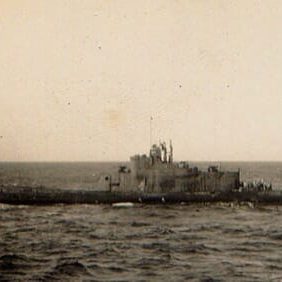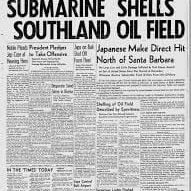On February 23, 1942, less than three months after Pearl Harbor, the first shelling in WWII on American soil took place. Off the coast of Goleta Beach, Japanese submarine I-17 surfaced and fired around 25 haphazard shots across the oil field, with the intent to disable American power sources. While no significant damage was done, American fears were reignited about an invasion from the Pacific.
On Monday, February 23, 1942, at 7:00 PM, President Franklin D. Roosevelt updated the nation on the latest events of World War II in his 20th fireside chat, On the Progress of War. Meanwhile, at sundown off Ellwood Mesa in present-day Goleta, CA, a Japanese submarine under the command of Nishino Kozo fired the first naval attacks on mainland American soil since the War of 1812. The attack left no casualties, but accusations that spies in Santa Barbara were flashing signals to the submarine brought support to the recently passed Executive Order 9066, which created Internment Camps that would hold about 120,000 Japanese Americans during the war. It was later determined that the lights seen during the Ellwood attack were likely headlights from a car driving along a winding road amidst the chaos.
Imperial Japanese Navy submarine I-17 launched the attack upon Ellwood’s Barnsdall-Rio Grande Oilfield. From about a mile offshore, the 365-foot sub fired up to 25 shells from its 5.5-inch deck gun. The shells caused minimal damage to a wooden pier, an oil derrick, and a pump house. Most of the shells landed in nearby fields, canyons, and ranches. The sub ceased fire after about 20 minutes and retreated south. U.S. planes gave chase to the sub, but Nishino got away. Thereafter, American coastal defenses were improved, so the mainland suffered only one more submarine attack by the Japanese during the war, at Fort Stevens in Oregon.


One of the shells blew a tin door (on exhibit) off a pump house. Photos in a nearby case show the pump house, the damaged pier, and large holes caused by shells that landed on nearby ranchland.
One of the episodes of California Gold with Huell Howser features the submarine bombing at Ellwood Beach.
One night after the Elwood attack, the Battle of Los Angeles took place. In response to claimed sightings of "enemy aircraft", anti-aircraft batteries opened fire across the city, causing panic among residents. Longtime SBMM docent and Ranger volunteer Bob Wightman remembers as a child standing outside his family home in Malibu hearing and seeing artillery light up the sky.
Japanese submarines continued to conduct occasional attacks against allied shipping off the U.S. coast during the rest of the war. Sent to American waters in hopes of targeting warships, the submarines managed to sink only a handful of merchant ships, besides conducting a few minor attacks on shore targets. These consisted of a bombardment of Fort Stevens on the Columbia River, an attack on a Canadian lighthouse on Vancouver Island, and two air raids launched from a submarine in an attempt to start forest fires in southwest Oregon.
Scouts are Strong for America: The Attack on Ellwood
Pete Langlo was a founding member of Troop One Goleta Boy Scouts. He was 12 years old at the time of the shelling and donated many artifacts from his time in the Boy Scouts watching over the coastline as a help to the military during the war. “As a Boy Scout, I would volunteer to be an airplane spotter, which meant I would go with an adult to a place up the coast past El Capitan Ranch to an old oil field shed that was wired for a phone. There we would listen and look for any planes. When one was heard and seen, we would phone it into Los Angeles central receiving, and they would make note of our report. They were all friendly aircraft of course, but to a 12 year old during the war, it was exciting.”
Learn About Our Other Museum Exhibits
Santa Barbara Maritime Museum has several other fascinating exhibits, and there's something fun for everyone in the family. Come learn about 13,000 years of human history in the Santa Barbara Channel, including the Chumash Indians, deep sea divers, shipwrecks, commercial fishing, and so much more. We also have several contemporary exhibits about the evolution of surfing, oil spills, whales, and marine life. There are several fun and interactive exhibits and activities for kids too.


